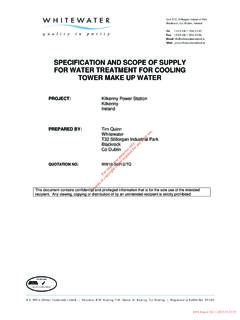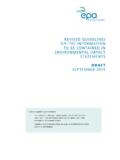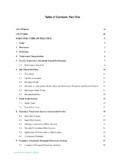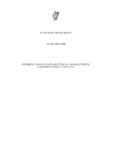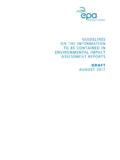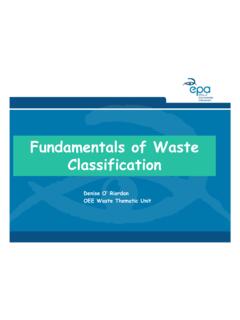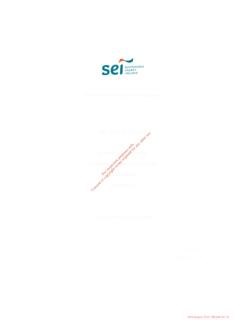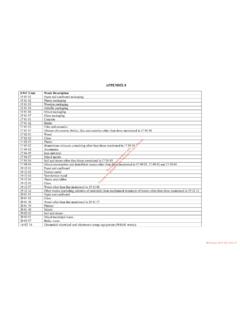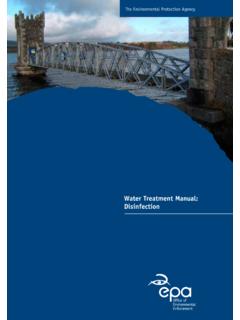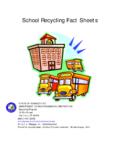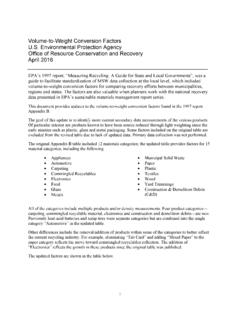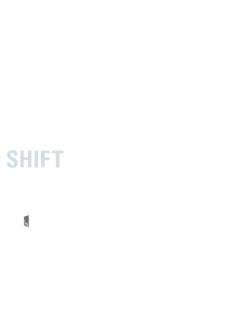Transcription of IRELAND’S ENVIRONMENT WASTE IN IRELAND
1 DID YOU KNOW? The total amount of WASTE generated in the state (industrial, commercial, household) at the last full survey was Million tonnes which is equivalent to tonnes per person The economic downturn has had a marked influence on municipal WASTE generation. It has decreased by 17% since it peaked in 2007 Household WASTE generated per person in IRELAND in 2011 amounted to 367kg which is considerably less than the EU average of 438kg One third of the food we buy ends up in the bin. This can cost the average household up to 1,000 per year IRELAND is amongst the top performing EU countries in terms of municipal WASTE recyclingThe last decade has seen huge change in relation to how WASTE is managed in IRELAND . IRELAND has moved quickly from a position of almost total reliance on landfill for managing WASTE to a high level of recovery of certain recyclable materials, with complex WASTE flows to and between different WASTE recycling and recovery 's first merchant municipal WASTE -to-energy incinerator commenced operations in 2011.
2 However there is a continued reliance on landfill, with 53 per cent of municipal WASTE landfilled in 2011 (down from 80% Landfilling in 2001). The household WASTE collection market has gone through a period of rapid transition, with many local authorities exiting the collection market in recent years, although local authorities still manage key municipal WASTE management infrastructure such as landfills, civic amenity sites and bring banks. The largest proportion of the Million tonnes of WASTE generated in IRELAND is mineral in nature associated with soils from construction, as well as mining and quarrying activities. IRELAND produces less total WASTE per person than the EU average ( IRELAND , EU average ). Municipal WASTE (from households, shops, commercial activities and similar) represents less than 15% of the total WASTE arising in the State.. WASTE POLICYW aste management continues to be a central issue for policy makers in IRELAND and the EU.
3 The most recent national WASTE management policy A Resource Opportunity, published in 2012, details how IRELAND will become a recycling society, with a clear focus on resource efficiency and the virtual elimination of landfilling of municipal WASTE . Legislation on segregation of WASTE for collection, and on an obligation to participate in a collection service (for households) are amongst the important recent policy PREVENTIONThe WASTE hierarchy ranks WASTE management options in terms of their environmental impact. WASTE prevention is at the top of the hierarchy and represents the most efficient and sustainable use of resources. The EPA National WASTE Prevention Programme (NWPP) supports businesses, households, communities, hospitals and others to be more resource efficient and to achieve cost savings, through WASTE prevention and reductions in water and energy consumption.
4 It has identified savings of approximately 40 million for Irish businesses over the last four years through a range of NWPP find out about IRELAND s resource use and WASTE prevention, check out the EPA website and the EPA factsheet on ENVIRONMENT and Economy . IRELAND S ENVIRONMENTWASTE IN eachproduceof household WASTE annuallyThe last decade has seen huge change in relation to how WASTE is managed in IRELAND . IRELAND has moved quickly from a position of almost total reliance on landfill for managing WASTE to a high level of recovery of certain recyclable materials, with complex WASTE flows to and between different WASTE recycling and recovery 1,000 Each year food WASTE coststhe average household up toNearly of householders disposalbin ismadeup PreventionPreparing for Re-useRecyclingOther recycling , RECOVERY & DIVERSIONI reland is well advanced towards achievement of its EU obligations across a broad range of WASTE legislation.
5 Overall recycling /recovery rates continue to climb, particularly in the municipal, packaging and WASTE from Electrical and Electronic Equipment (WEEE) WASTE streams. In 2011, IRELAND s municipal WASTE recycling rate (excluding energy recovery) was 40%, the same as the EU27. However some future targets for particular WASTE streams will pose a challenge and are further discussed quantity of non-hazardous WASTE used as a fuel increased by 42% in 2011 compared to 2010, due mainly to the use of solid recovered fuel at cement kilns. This percentage is set to rise with IRELAND s first merchant municipal WASTE incinerator commencing full scale operations, as well as increasing export of WASTE derived fuels to EU WASTE to energy development of recycling industries within IRELAND offers considerable economic and employment opportunities but is influenced by the size of the Irish market.
6 As a result, IRELAND is still dependent on export arrangements for certain WASTE streams. In 2011, nearly half of hazardous WASTE managed was exported for treatment and over 70 per cent of municipal recyclables such as cardboard, glass and metals were exported for treatment due to limited recovery infrastructure for these WASTE streams in IRELAND ..OTHER WASTE STREAMSPACKAGING WASTEI reland has been compliant with all statutory packaging recovery targets set since 2001. In 2011, the recovery rate was 79%, which surpassed the EU target of 60% recovery. WASTE ELECTRICAL AND ELECTRONIC EQUIPMENT (WEEE) IRELAND is compliant with the requirements of the WEEE Directive. Recovery rates for all categories of WEEE have been achieved. In 2011, household WEEE collected for treatment amounted to kg per person, which exceeded the 4 kg per person BATTERIESThe Batteries Directive set a target of 25% portable battery collection, relative to tonnage placed on the market, for 2011.
7 IRELAND met the target by achieving a 29% collection rate, although we are at risk of not meeting the 2016 target of 45%.END-OF-LIFE VEHICLES (ELVS)In 2011, a reuse/recovery rate of 82% and a reuse/ recycling rate of 80% were achieved against the 2006 targets of 85% and 80% respectively. More stringent targets of 95% reuse/recovery and 85% reuse/ recycling come into force in January 2015 which present a strong challenge to WASTEW aste is classified as being hazardous when it displays properties that make it dangerous or potentially harmful to human health or the ENVIRONMENT . The pharmaceutical and chemical industries are the largest generators of hazardous WASTE in IRELAND , though substantial amounts, such as WASTE batteries, paints etc. are also generated by households. The overall quantity of hazardous WASTE managed has not changed substantially in recent & DEMOLITION (C&D) WASTEIn 2011, C&D WASTE collected had decreased by 83% since a peak of Mt in 2007.
8 The decline in the economy and the sharp fall-off in construction activity has had a direct effect on this WASTEM unicipal WASTE in IRELAND is made up of household WASTE , commercial WASTE (including non-process industrial WASTE ) and cleansing WASTE ( , street sweepings, municipal parks and cemeteries maintenance WASTE ). Municipal WASTE generation has decreased in IRELAND since a peak in 2007, despite an increase in population. The economic downturn, resulting in decreased personal consumption of goods and services has been a particular economic downturn has impacted on the generation of certain WASTE streams. However, forecasts show that the total volume of municipal WASTE is likely to increase over the next fifteen years once economic recovery takes hold, necessitating future investment in WASTE management infrastructure. The national landfill levy as well as EU legislation will continue to be primary drivers of change in relation to WASTE management practices in IRELAND .
9 However, while IRELAND has made significant progress in meeting many EU WASTE recycling /recovery targets, there are still challenges in relation to WASTE generation and management of particular WASTE streams, such as end of life vehicles and biodegradable municipal the coming years, implementation of the National WASTE Prevention Programme and the plans detailed within A Resource Opportunity will be critical to assist in the decoupling of WASTE generation from future economic growth in IRELAND . IRELAND S ENVIRONMENTWASTE IN IRELANDC onstruction &DemolitionWasteRecovery ratesfor all categoriesof WEEE have MUNICIPAL WASTE (BMW)BMW comprises those elements of the household, commercial and cleansing WASTE streams that will rot or degrade. The main constituents of the biodegradable proportion of municipal WASTE are typically parks and garden WASTE , food WASTE , timber, paper, card and are targets under the Landfill Directive to divert BMW from landfill.
10 IRELAND met the first diversion target (due by July 2010), which was to landfill a maximum 75 per cent of the BMW generated in 1995. Early indications are that IRELAND will also meet the 2013 target. The 2016 target, which is to landfill a maximum 427,000 tonnes of BMW is likely to present a challenge for IRELAND .!Packagingwasterecoverycompliant since2001
